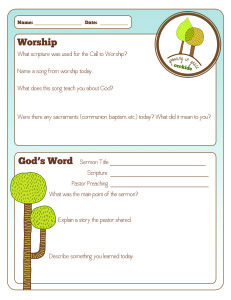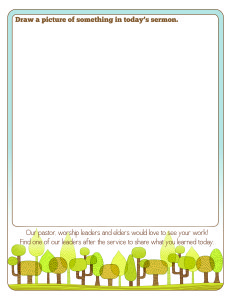
We are pleased to present a new tool for helping children participate in our weekly worship services. Our new Worship Guide is a simple worksheet that asks children to respond to what is happening in the worship service. We are excited about this new tool for several reasons, but most importantly we believe that God desires the worship of children as well as adults and we hope this will help children to more fully engage with what is happening in the worship service.
You will be able to find printed copies of the new Worship Guides each Sunday at the Children’s Welcome Station or at the Resource Desk in the Foyer. You can also view a printable pdf version of the document here: Worship Guide for Children. The guide is designed primarily for children who can read and write, but there is a space on the back for children to draw a picture of something from the sermon that can be used by children of any age.
Our pastor, Rob Pendley, and our Worship Director, Chris Hiatt, will be visiting with our 2nd-5th graders this Sunday, May 25 during the 9 am Education hour to share with them why our worship services are constructed they way they are and how children are a part of the worshiping body of believers, as well as to introduce the new Guide to the children. We encourage children this age to be here this Sunday to hear this important presentation and be able to ask Pastor Rob and Chris any questions they might have.
And finally, Rob and Chris and our Session of Elders are excited to hear about what your child might be learning during our worship services. We want to encourage children to share their thoughts from the Guide or their drawings with Rob, any of the worship leaders, or members of the Session.
If you made it out to the adult ed class yesterday, you might have heard Rob mention our summer reading plan. This is a simple suggestion of how to spend deliberate time in the Bible this summer. Quarter sheets with the the suggested readings are available in the foyer. If it’s part of your daily routine already, the suggested readings are divided up into morning and evening Psalms. If it isn’t a part of your day, then the readings are an excellent way to start. Pick one from each day and read it before bed, or get up five minutes early and read the morning Psalm. Give it a try and let me know how it goes. If the plan is helpful to you, or if it could be better, we would love to hear from you.
The plan started yesterday and will continue through August 10. We pulled the readings from the ESV “Daily Office Lectionary”. You can access the daily office online as well by heading over to Crossway’s site. They even have an iCal option that will push to your calendar. Check it out here. Note that if you use the online tool, you’ll be presented with the full readings for the day. We are just working through the Psalms together.
We will also be using the lectionary in our corporate worship this summer, drawing from the Psalm designated for each Sunday and exploring it somewhere in our liturgy. Yesterday, we sang “The King of Love My Shepherd Is”, based on Psalm 23.
If your office is anything like mine, a few weeks of work will render your desk almost completely useless – cluttered with stacks of books, paper, abandoned coffee mugs, etc. Every now and then, I have to take a step back and think about the purpose of my work space and ultimately consider how it’s condition reflects and affects part of who I am. In this case, that’s a bitter pill to swallow, and I usually end up cleaning it and vowing to keep it that way. This time I’ll keep up with it! I think we all know how that usually goes. Thus the cycle continues; but the cycle itself can be helpful in that it causes me to reevaluate from time to time, and to optimize my space periodically.
Much of my attention and energy has been drawn to our space lately. Consider the sanctuary – a room designated for corporate renewal through worship, the sacraments, teaching, events, and ceremonies. If I dwell on it for a minute, what are the features of that room that help characterize our gatherings? Does it in any way reflect who we are? Maybe a more basic question is: Does the state and condition of that space matter?
I argue that, just as our worship should bring order and beauty to bear on the Christian story through liturgy, so should the space we share. That concept is implicit in the architecture and craftsmanship of our building. Even down to the finishes, it’s hard to deny that those involved in its design and construction understood how important a building is to our congregation (consider the flooring, the quality of our kitchen, or the sanctuary ceiling as a few examples). The way we use the space, even down to the arrangement of the furniture, has meaning as well, and it is shaping and forming us as we gather there (just like my messy desk). Over the past few weeks, we have been working in our worship space, modifying it in subtle but intentional ways, and I want to share our intentions with you.
Seating: If you’ve been there this month, you’ve no doubt noticed the new chair layout. We elected to remove the “curve”, which was originally designed to orient everyone directly toward the pulpit and communion table (symbolizing the centrality of the word and the importance of the sacrament), while also orienting the congregation in on itself (encouraging community). It actually gave us more seating than before, but we lost a sense of order and symmetry in the process. It was almost impossible to maintain, and every time we moved the chairs for an event, we had too much difficulty setting them up correctly. Our most recent setup is similar to our original arrangement, with a strategic change. A “center” aisle now runs from south to north, directly from the entry doors. This aisle makes the entire room more accessible, and it results in quicker and easier seating, especially later in the service. We also opened up space for ushers to direct and guide the congregation, and we are seeking to make communion, the family meal of Christians, more fluid. A critique of the arrangement has been that it feels more fragmented, and even back heavy. Down the road, we might look for opportunities to foster community within subsections. I’d encourage you to use the subsections as opportunity to be hospitable, both to the newcomer and to the person whose face you recognize but name you can’t recall. It’s also worth noting that the design should create pathways within the sanctuary to make movement easier, and we are also seeking to preserve the rear, southernmost section for newcomers and those who arrive late for one reason or another. The new table that’s set up in the entry way should help divert us around the nearest seats, leaving them for those who might need them (new parents with a nursing child, those who need to leave early, etc.).
Reducing Clutter: It’s a constant struggle for me to keep my personal areas clutter free; and it’s one that I often lose when I’m fighting it alone. A communal area like our sanctuary is compounded in that it has so many people using it. But the worship and tech ministry are working together to remove clutter from the stage and even the sound booth. Special thanks to Justin Richardson for his tireless efforts there. The sanctuary is also cleaned twice a week, rather than once. With the diligence and help of all who gather here, we can work together to remove distracting microphone cables, abandoned coffee mugs, old bulletins, etc. Hopefully, if you’ve read this far, you are getting a sense of how I hope we can learn to value that space and steward it well, just as we seek to see it used more frequently as a gathering place. Thank you for reading! See you Sunday.
This year we will hold one service on Christmas Eve at 6:30pm. All ages are welcome, and there will be care provided for infants through age 3. We’ll observe the Lord’s supper, sing carols and be reminded of the true meaning of Christ’s advent into the world. As the Christ candle on our advent wreath is lit to symbolize the birth of Jesus, we’ll fill the room and the sky with its light.
I hope you will make this special worship service a part of your Christmas celebration!
Note: This post was edited to correct mistaken information about childcare. Cutoff is age 3, not 3rd grade as previously stated.
For the last several months we’ve been mulling over a slight but important change in the way we handle references to God in our gatherings. This Sunday, you might notice some changes in the way the service’s content is presented. For those interested, we wanted to make you aware of our policy moving forward:
For clarity and consistency, we will attempt to reflect scripture and songs as conveyed in the English Standard Bible and/or the Trinity Hymnal, where applicable. This includes both the worship folder and the overhead projection.
This means specifically:
- Pronouns referring to the Trinity are not capitalized; this is in accordance with the majority of Bible translations, with the general rules of the English language, and with the original Greek and Hebrew texts.
- Names of all members of the Trinity are capitalized, as are other proper nouns, even where they are not in the Hymnal or other popular music texts.
If you’d like to reflect on this subject, we found this overview from Randy Alcorn to be helpful. Glory to God. See you Sunday!
About This Blog
This blog is one of the primary ways that Christ Community's staff can connect and share information. Look for important updates on our community life here each week.
Visit the CCC Website.
View our Church Calendar.
Subscribe via Email
Reminders & Reflections
Blog Archive
- June 2015
- May 2015
- April 2015
- March 2015
- February 2015
- January 2015
- December 2014
- November 2014
- October 2014
- September 2014
- August 2014
- July 2014
- June 2014
- May 2014
- April 2014
- March 2014
- February 2014
- January 2014
- December 2013
- November 2013
- October 2013
- September 2013
- August 2013
- July 2013
- June 2013
- May 2013
- April 2013
- March 2013
- February 2013
- January 2013
- December 2012
- November 2012
- October 2012
- September 2012
- August 2012
- July 2012
- June 2012
- May 2012
- April 2012
- March 2012
- February 2012
- January 2012
- December 2011
- November 2011
- October 2011
- September 2011
- August 2011
- July 2011
- June 2011
- May 2011
